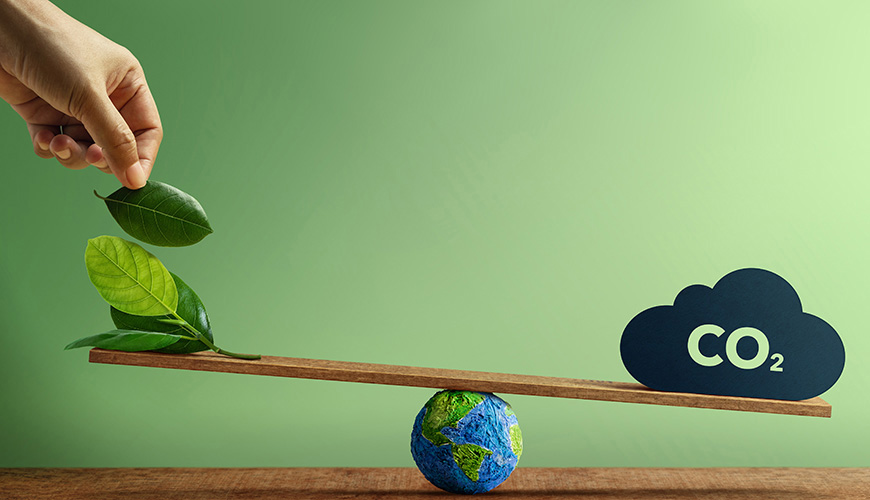The carbon footprint is the global indicator that quantifies the greenhouse gases we emit. Reducing it is not an impossible task, but with its reduction we can contribute to taking care of the planet and curbing global warming.

To understand the environmental impact that the pandemic had on the world, it is useful to refer to the figures of the tons of carbon dioxide that were emitted in 2020, when the planet stopped to protect itself from Covid-19. According to the World Bank, the same 33.5 kilotons of CO2 emitted during 2012 were recorded that year. It was like going back in time 8 years. However, as soon as vaccines appeared, demand for fossil fuels resumed its accelerated march and both companies and individuals once again put their share of the global carbon footprint.
The latter refers to the indicator that quantifies the CO2 emissions produced by a person, organization or country. At the 2015 COP21 climate change, Colombia committed to the Paris Agreement to reduce its greenhouse gas (GHG) emissions by 51% by 2030 and achieve carbon neutrality by 2050. However, the country’s emissions continue to rise and the International Energy Agency (IEA) ranked us 137th out of 184 emitting countries in its latest report. To understand the measures that would be necessary to achieve this ambitious goal, we interviewed engineer Liven Fernando Martínez, a professor at the National University of Colombia and an expert in environmental impact assessment, who also explained the importance of each person evaluating their impact and taking actions to reduce their emissions.
How is the carbon footprint calculated?
In general, what is done is to add three scopes: direct emissions, which have to do with the greenhouse gases that are generated by the use of fossil fuels such as gasoline, diesel and coal. To calculate it, a conversion of the amount of fuel consumed is made and multiplied by the emission factor, in Colombia some of these factors are defined by the Mining and Energy Planning Unit (UMPE).[1] The second scope has to do with indirect emissions from the energy consumption of household appliances, it is calculated for each kilowatt or unit of energy, how many tons of CO2 equivalent were generated. And the last one is indirect emissions that are not associated with energy consumption. These include those generated by the decomposition of waste, those generated by the private vehicles of the members of the organization, air travel, emissions of refrigerant gases, etc.
We are not a country with a high CO2 emission per capita, why should we as individuals care about our carbon footprint?
We may not have that relevance as a country, compared to other industrialized countries, but that does not shirk the responsibility we have as human beings. By quantifying my carbon footprint, I can get an idea of what actions to take to minimize it.
Where do we start reducing those emissions?
To reduce direct emissions, there are many alternatives focused on relying less on fossil fuels: replacing traditional vehicles with hybrids or electrics; use a less polluting fuel such as bioethanol or biodiesel; Get around by bike or mass public transport. We can also think about generating energy from renewable sources with solar panels, wind farms and turbines in rivers or at sea.
For indirect emissions, we can buy energy-saving equipment or design buildings that take advantage of natural light, have LED lighting and natural ventilation. Finally, to reduce fugitive emissions, we can avoid commuting and encourage teleworking, buy local products, minimise food waste or take advantage of organic waste with techniques such as composting.
Who measures the carbon footprint? Are we obligated as a country to report it?
There are different scales, if we think at the level of a company there is an ISO standard of environmental management requirements and there are several certifiers in the country. But it turns out that we also have international commitments that the country has acquired, such as the Paris Agreement. The carbon tax and other instruments allow us to obtain this information at the national level. In the case of a person or household, we can also quantify it with the electricity bill for electricity consumption, fuel expenditure and recycling habits. The National University has an individual carbon footprint calculator available on the web.
Do you think Colombia will be able to reduce its emissions by 51% in the next 5 years and reach carbon neutrality by 2050?
It should be clarified that this information is built on a trend scenario, not on an absolute value. Different strategies have begun to be implemented at both the policy and regulatory levels, in the medium and long term. From the point of view of discouraging fuel consumption, the carbon tax reduces fuel consumption because it rewards those who are more efficient, although today it is only charged to those who sell fuels at service stations. There are also incentives for the energy transition, and if we diversify that matrix, we meet the demand for energy with other sources with a lower carbon footprint. But environmental education is a very important strategy, people do not generate emissions of risk, but it is a matter of ignorance.
Why is conserving forests and promoting reforestation projects urgent to achieve this goal?
If we already manage to be as efficient and environmentally sustainable as possible, we can think about mitigating the damage with strategies such as reforestation. From the point of view of plant biology, when the tree begins to grow is when it captures more carbon from the atmosphere to integrate it into its structure and form lignin, wood, etc. This phase is when it has the greatest potential to fix that CO2 and reduce the gases that are in the atmosphere, which is why planting trees is a very good option. Actions such as reforestation and restoration of soils and oceans are also necessary to mitigate environmental damage.
What are carbon credit markets and what is missing to make it a comprehensive solution against global warming?
If I have a forest and I quantify the carbon it captures, I can sell that certificate through a third party to a carbon emitter who may be in another country. That’s what carbon credits are all about. However, we are not really changing the situation there, because that company must also commit to reducing its emissions.
When talking about carbon credit trading, it is important to ensure additionality. We need to increase this sequestration potential, both at the level of vegetation and at the level of the soil, which is one of the main carbon reservoirs. If I have a healthy and fertile soil, it can serve as a substrate and provide nutrients, but if we continue to burn the vegetation to facilitate cultivation or livestock, we are deteriorating that resource. The ocean is also one of the main reservoirs of carbon, we are affecting our rivers and seas with untreated wastewater and killing the microorganisms responsible for doing that carbon fixation process. So if we focus on just one thing, we are ignoring that the biosphere is one and that everything is interconnected.
How can we ensure the sustainability of mechanisms such as carbon credits for the benefit of communities?
It is very important to conserve the National System of Protected Areas or national parks, as they are areas that fulfill ecosystem functions such as carbon fixation, water regulation, temperature regulation. But it is also important to meet people’s needs for food and income. Not only can we prohibit the use of a certain product or soil, we must provide alternatives that allow them to make use of these resources in a sustainable way: ecotourism, the mixture of forest species with fast-growing species, or the use of species such as beekeeping or fruits to generate local products are integral solutions.
What is the ecosystem value of the Amazon to mitigate global emissions?
It is fundamental, part of our survival as a species depends on its conservation, but it is continuously threatened by deforestation and other illegal activities such as mining. This ecosystem helps to capture that carbon and purify the air, regulates the temperature worldwide, and is a reservoir of immense biodiversity. Human beings are just another species: we can be in the city and believe that we have everything, but without that natural base, we will have neither water nor air. We depend very closely on the good state of conservation and functioning of this ecosystem and nature in general.
6 Things You Can Use to Reduce Your Carbon Footprint at Home
- Carry your own bottle and cloth bag to avoid single-use plastics.
- Reduce the use of private vehicles: walk, bike or use mass public transport.
- Separate your waste into green bags for organics (food scraps), white bags for recyclables (plastics, glass, metals, or paper), and black bags for non-recyclables (napkins and toilet paper).
- Have few appliances and unplug them when not in use.
- Make sure your bulbs are LEDs, they use less energy.
- Buy local produce and avoid those transported from faraway places.
What is the purpose of measuring my footprint?
- To know my contribution or that of my company to global warming.
- Identify if my energy use is efficient.
- Discriminate the general and specific contribution of my actions.
- Neutralize carbon with initiatives such as reforestation.
- Change technologies to lessen the impact.
Liven Fernando Martinez
He is an agronomist and holds a master’s degree in Environment and Development from the National University. He holds a PhD in Tourism, Economics and Management from the University of Las Palmas de Gran Canaria, Spain. He is currently part of the Institute of Environmental Studies of the National University, Bogotá, where he is a professor of the Master’s programs in Environment and Development; of the Specialization in Tourism, Environment and Territory, and of the diplomas in Environmental Economic Valuation and Environmental Impact. For the past 12 years, he has focused his research on environmental impact assessment and the application of sustainability tools for companies.
[1] https://www1.upme.gov.co/siame/Paginas/calculo-factor-de-emision-de-Co2-del-SIN.aspx


